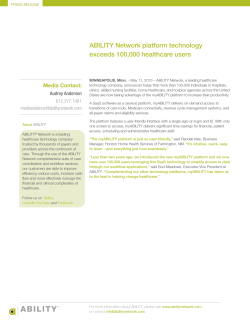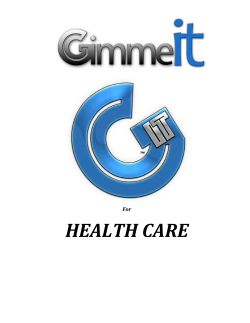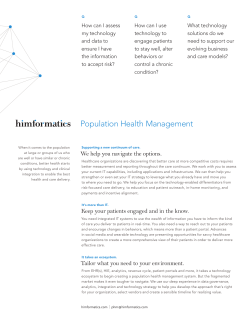
Spanish for Healthcare
Spanish for Healthcare Melissa Swarr Hempsfield School District Pennsylvania What is Spanish for Healthcare? Spanish for Healthcare is a course that I proposed in my district focused on healthcare themes, structures, and issues -- with a concentrated focus on verbal communication skills (over writing/reading) and interpretation skills. It focuses on communication in a healthcare theme, not healthcare skills. Why Propose Spanish for Healthcare? • Basic Spanish I/II in nursing college did not provide students with the conversational skills needed to communicate with patients. • Though taboo and a possible liability, nurses were still being asked to interpret for doctors. • There is a need for practical application of language skills! • Because I asked! (I have no background in healthcare!) • Selfish reasons… How do you propose a course like this? • I approached the department coordinator to discuss the need for a course for healthcare-bound students. (Our high school students had more language skills than what I was seeing at the community college.) • Prerequisite: Level IV high school Spanish • Course Proposal/Approval: At least one year (to get into curriculum guide for course selection) • Budget consciousness… be aware that not many districts will approve a book purchase in the current economic challenges. (I had books and curriculum in my proposal, but both were denied.) First Semester Planning • I decided how I wanted to approach such a broad theme and mapped out my topics, vocab targets, and grammatical structures. • The students gobbled up an entire week of my preparation in less than the first two days! • No textbooks means you are “it” – for each and every list, lesson, activity, assessment. • There were several times during the first semester where I was only a day or two ahead of the kids. It is work, but the reward was worth it. Further Planning • The nurses and nursing students were looking for something in the Spanish course that wasn’t being delivered – I knew what the ‘currency’ was for those in the field. • Think about supplemental materials/tech gadgets/sites that you could use to help lighten your workload. • Some things that I had to explain to my supervisor and principal as they set out to observe this class…it does not always look like our typical language setting. • *Remember – you are teaching communication skills for the healthcare field, NOT healthcare skills. Teachers and Students Who takes the course? • Any student looking to go into any field of health who has completed our level IV. Who teaches the course? • At this point only the person that proposed and prepared the course has taught it (or wants to). (Job security!) When is a good time to teach a new course? • When is a good time to dive into a new course, prepare every piece of material and every word so that it correlates to your specific topic– every worksheet, activity, idea, homework, project, etc.? (Is it ever a good time?) • Would you welcome a switch from teaching the same basics over and over? This is the course where I can have a little freedom and a little fun. I’m not tied to “covering” material in the curriculum, and knowing they are moving to a colleague for another level. Additionally – the type of student signing up for this level and this type of specified course is typically a very self-motivated individual, and chooses to take the course based upon personal goals rather than fulfilling university entrance requirements. Challenges • The process takes time – supervisor approval, proposing the course and administrative approval… then into curriculum guides and talking it up before students can register. • No matter how much you prepare, you are never prepared enough until you teach through a new course once. Expect frustration at times. • No matter how much you plan, when the students are learning you will realize that there are changes to your course (order of things, topics, etc.) that you can make in order to make the course better. • No human is a walking encyclopedia, a fountain of information, or a Google search button… there will be questions that you do not know the answer to… simply say you do not know, find out, and get back to the student. (But do use trustworthy sources.) Other Issues • Frankly, any new course is a lot of work for a teacher. A new course that you create all materials for is even more work. Arm yourself with plenty of reference materials to pull from. Use resources to help you… I made myself a book and used Edmodo to help me. • Teacher flack and negative peer feedback… all departments are different. You may have teachers who are jealous, some who are envious, and some who are angry. The answer for this is simple. • Don’t bank on first year numbers to be the norm. New courses, new interest, ebbs and flows… eventually it all evens out. My class ran four sections the first year and has evened out to two per year (one per semester) with full classes between 20-28. • Word of mouth is a powerful tool… an example of meat and potatoes, and the teacher everyone loves, but the course they hate. The first time you run the course- though you expect issues, you also want to do it very well because these students will be your walking advertisement for the course for future registrants. • ** A special admonition for a healthcare course…(liability, interpretation issues) Course Goals • Rote skills are what many ‘traditional’ (non-TPR/TPRS) teachers lean on for beginning language levels (and the way that many of US learned a second language). This turns into production for very confident students, very vocal students, and very motivated students… what about the rest? (Your goal should be communication… i.e., let go of a missed written accent, instead focus on the spoken accent. It is this way in most language courses, but especially so in courses for specific purposes.) • Implementing a course based on production provided some opportunity for sincere reflection on totality of classroom practices. To get them all speaking, the major focus MUST be communication. Communication is #1 Goal What is Language? Language is COMMUNICATION. Communication is IMPERFECT… Goal for any language classroom: P-R-O-D-U-C-T-I-O-N Classroom Environment & Activities Language skills are not based solely on vocabulary, and you cannot base a course solely on vocabulary. • Establish an environment based on production, not perfection. • Reevaluate pencil/paper assessments and their value in upper levels... or reevaluate their format. • Create a classroom of ACCEPTANCE, student-centered activities. • Promote spontaneous production wherever possible. (This has been my single-most proudest accomplishment in this course.) Resources Course Proposal Excerpt See this and more at NBLE.ORG Year At-A-Glance Contact Information Cristin Bleess cristin.bleess@dcsdk12.org Janet Graham Mary Risner mrisner@latam.ufl.edu Melissa Swarr melissa.swarr@comcast.net
© Copyright 2025









